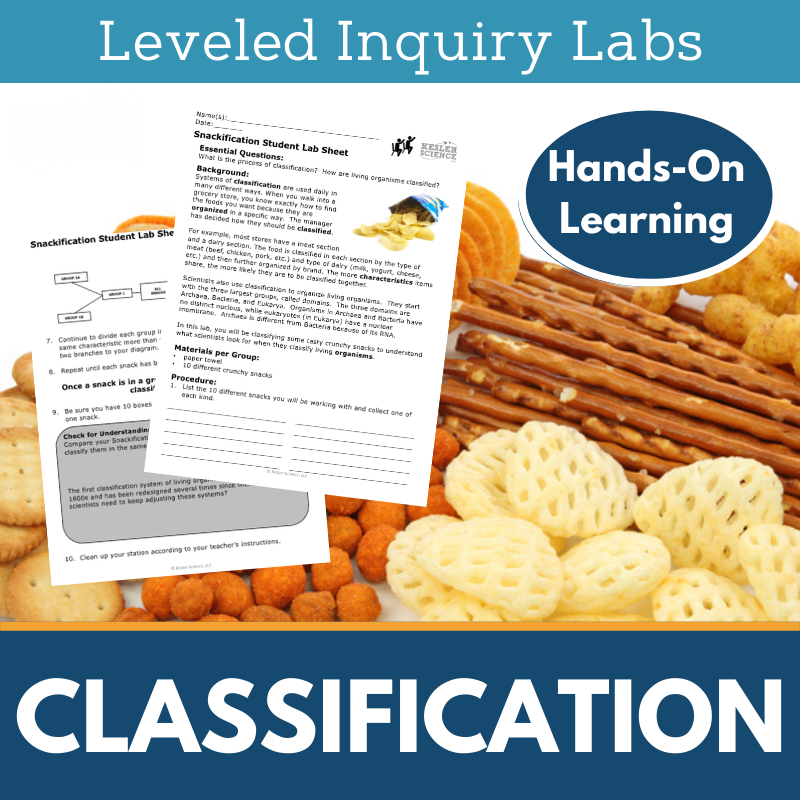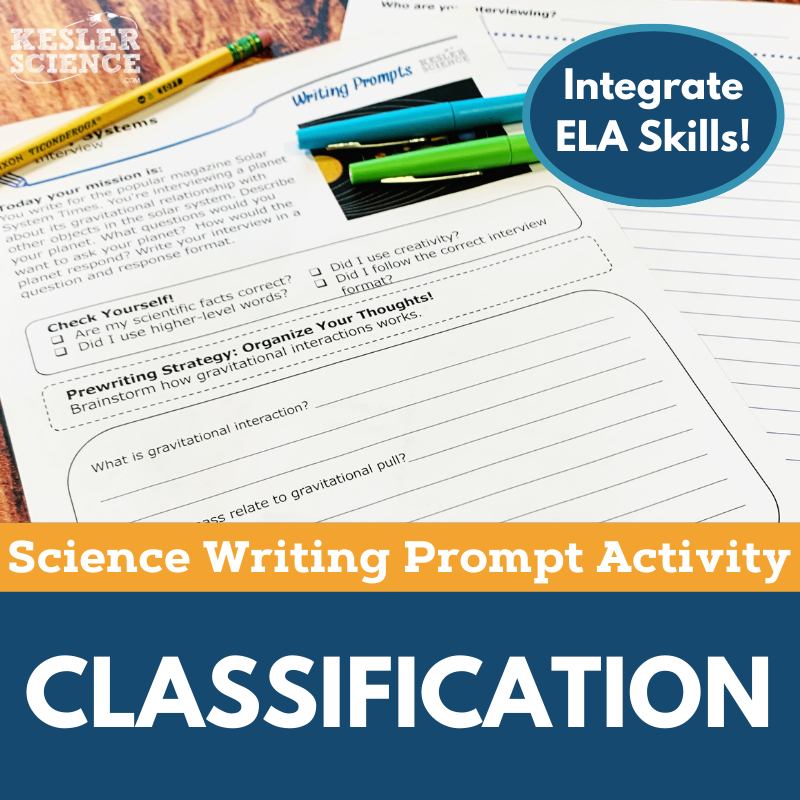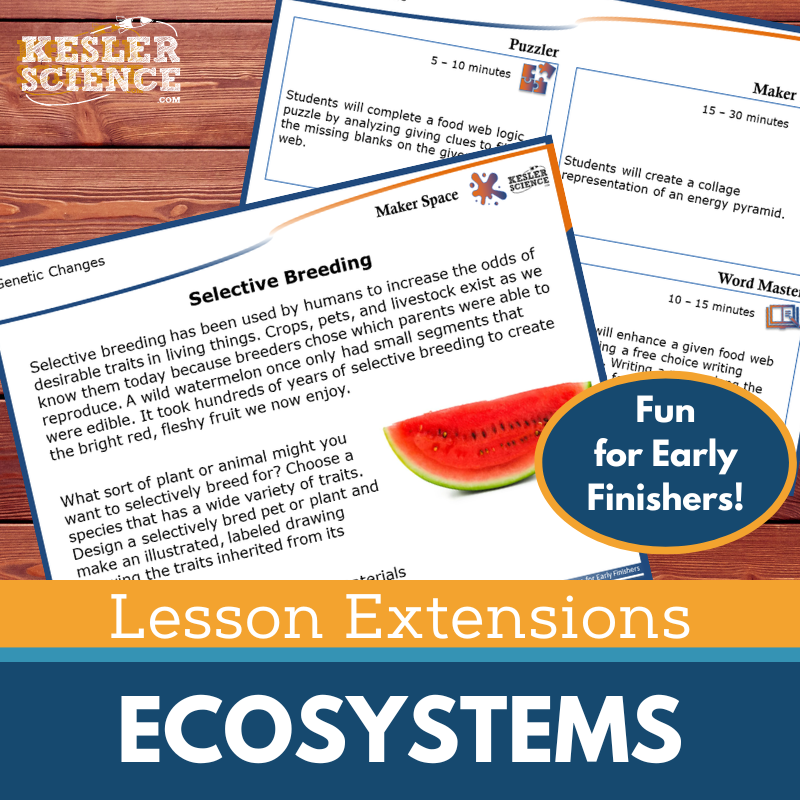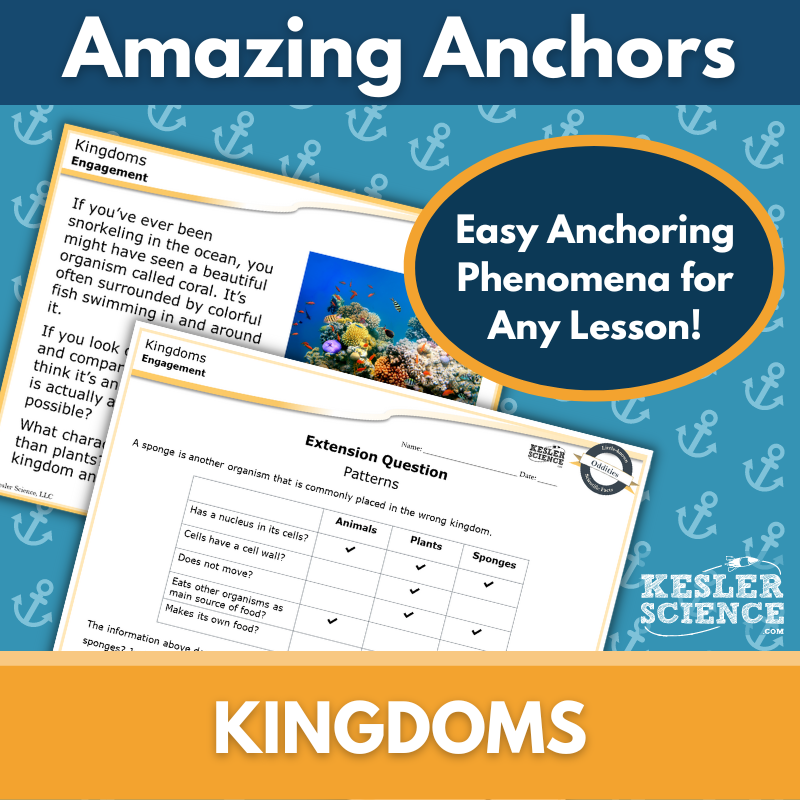Characteristics of Kingdoms Activities for Middle School Science
Explore the characteristics of the six recognized kingdoms and their roles in ecosystems with this engaging 5E lesson aligned to TEKS 7.14B. The resources below will give students a comprehensive understanding of the characteristics of kingdoms. All of the following materials are also included in the Kesler Science Membership.
The Kesler Science Characteristics of Kingdoms 5E Lesson provides a comprehensive middle school unit on the characteristics of the six recognized kingdoms and their roles in ecosystems, such as bacteria aiding digestion and fungi decomposing organic matter. The lesson includes editable presentations, worksheets, student-choice projects, and assessments, designed for differentiated, student-led learning with minimal prep. It aligns with TEKS 7.14B and is available in both digital and printable formats.
Following the 5E Model, the lesson begins with engaging discussions and vocabulary-building activities in English and Spanish. Students explore the classification of organisms through a hands-on, student-led station lab featuring multimodal input and output stations. These stations include hands-on demos, reading passages, videos, research tasks, categorization activities, writing prompts, and illustration exercises. A bonus challenge station extends learning for advanced students.
Explanation materials include editable PowerPoints, interactive notebooks, and note-taking templates in multiple formats. Students elaborate on their understanding through choice projects, while evaluation resources include STAAR 2.0-aligned assessments, review worksheets, and discussion questions. The flexible format supports both in-class and virtual learning.
The Kesler Science Characteristics of Kingdoms 5E Lesson provides a comprehensive middle school unit on the characteristics of the six recognized kingdoms and their roles in ecosystems, such as bacteria aiding digestion and fungi decomposing organic matter. The lesson includes editable presentations, worksheets, student-choice projects, and assessments, designed for differentiated, student-led learning with minimal prep. It aligns with TEKS 7.14B and is available in both digital and printable formats.
Following the 5E Model, the lesson begins with engaging discussions and vocabulary-building activities in English and Spanish. Students explore the classification of organisms through a hands-on, student-led station lab featuring multimodal input and output stations. These stations include hands-on demos, reading passages, videos, research tasks, categorization activities, writing prompts, and illustration exercises. A bonus challenge station extends learning for advanced students.
Explanation materials include editable PowerPoints, interactive notebooks, and note-taking templates in multiple formats. Students elaborate on their understanding through choice projects, while evaluation resources include STAAR 2.0-aligned assessments, review worksheets, and discussion questions. The flexible format supports both in-class and virtual learning.
Engage your students with this student-led station lab aligned to TEKS 7.14B, focusing on describing the carbon cycle. Designed for in-class or virtual learning, this life science lesson allows students to direct their own learning through nine interactive stations featuring videos, readings, research, and hands-on tasks.
Students explore new concepts through activities like demonstrations, videos, reading passages in English and Spanish, and research-based tasks. They demonstrate their understanding by organizing information, illustrating models, writing responses, and completing assessments. A bonus challenge station provides extension activities for early finishers.
This low-prep, high-engagement resource supports differentiated learning and promotes critical thinking in the classroom.
Engage your students with this student-led station lab aligned to TEKS 7.14B, focusing on describing the carbon cycle. Designed for in-class or virtual learning, this life science lesson allows students to direct their own learning through nine interactive stations featuring videos, readings, research, and hands-on tasks.
Students explore new concepts through activities like demonstrations, videos, reading passages in English and Spanish, and research-based tasks. They demonstrate their understanding by organizing information, illustrating models, writing responses, and completing assessments. A bonus challenge station provides extension activities for early finishers.
This low-prep, high-engagement resource supports differentiated learning and promotes critical thinking in the classroom.
The Characteristics of Kingdoms Student Choice Projects align with the 2021 TEKS standard 7.14B, allowing middle school students to select a project that matches their preferred output style. A project page outlines six student-led options plus a “design your own” project, with an editable rubric for teacher, peer, or self-assessment. This resource is also included in the Characteristics of Kingdoms Complete Lesson for TEKS 7.14B.
These flexible, multimodal projects provide creative ways for students to demonstrate their understanding. Two versions of the project page support differentiation, with modified options for students needing remediation and challenge opportunities for advanced learners. Teachers can adjust the rubric to fit grading needs.
The projects require standard classroom supplies like paper, markers, and scissors, with many options available for digital completion.
The Characteristics of Kingdoms Student Choice Projects align with the 2021 TEKS standard 7.14B, allowing middle school students to select a project that matches their preferred output style. A project page outlines six student-led options plus a “design your own” project, with an editable rubric for teacher, peer, or self-assessment. This resource is also included in the Characteristics of Kingdoms Complete Lesson for TEKS 7.14B.
These flexible, multimodal projects provide creative ways for students to demonstrate their understanding. Two versions of the project page support differentiation, with modified options for students needing remediation and challenge opportunities for advanced learners. Teachers can adjust the rubric to fit grading needs.
The projects require standard classroom supplies like paper, markers, and scissors, with many options available for digital completion.
The Kingdom Classification Inquiry Lab aligns with TEKS, helping students classify organisms based on characteristics such as cell type, cellular organization, nutrition, and reproduction. In this lab, students create new organisms that fit within the current kingdom classification system, then trade organisms with another group for identification. At the independent level, students compare two protists using a Venn diagram and conduct internet research to differentiate phyla within the Animalia kingdom.
This resource includes three differentiated labs to support diverse learners. The dependent lab provides a structured experience with guided inquiry questions, the modified lab includes sentence stems and multiple-choice options for additional support, and the independent lab allows students to take full control of the investigation with minimal guidance.
Teacher resource pages outline objectives, materials, and instructions, while answer keys and CER-based reflection questions support assessment. All pages are editable. Required materials include colored pencils, a coin for flipping, a dichotomous key, and internet access for independent-level research.
The Kingdom Classification Inquiry Lab aligns with TEKS, helping students classify organisms based on characteristics such as cell type, cellular organization, nutrition, and reproduction. In this lab, students create new organisms that fit within the current kingdom classification system, then trade organisms with another group for identification. At the independent level, students compare two protists using a Venn diagram and conduct internet research to differentiate phyla within the Animalia kingdom.
This resource includes three differentiated labs to support diverse learners. The dependent lab provides a structured experience with guided inquiry questions, the modified lab includes sentence stems and multiple-choice options for additional support, and the independent lab allows students to take full control of the investigation with minimal guidance.
Teacher resource pages outline objectives, materials, and instructions, while answer keys and CER-based reflection questions support assessment. All pages are editable. Required materials include colored pencils, a coin for flipping, a dichotomous key, and internet access for independent-level research.
The Classification Escape Room is an interactive activity that reinforces concepts of organism classification in a fun and engaging way. Designed to align with TEKS, this escape room challenges students to recognize taxonomic classifications and identify key organism characteristics such as cell type, structure, and mode of reproduction.
Teachers have full control over the eight independent puzzles, allowing customization to fit different class lengths and student needs. The activity can be set up using manila envelopes and printed materials or enhanced with physical locks and a storage box for a more immersive experience. A digital version is available for online learning via PowerPoint or Google Slides, with a printable option for home use.
This resource includes teacher directions, answer keys, a digital answer sheet, video challenges, printable props, prize ideas, and reward templates. With engaging puzzles and interactive elements, students will be fully immersed in this standards-aligned learning experience.
The Classification Escape Room is an interactive activity that reinforces concepts of organism classification in a fun and engaging way. Designed to align with TEKS, this escape room challenges students to recognize taxonomic classifications and identify key organism characteristics such as cell type, structure, and mode of reproduction.
Teachers have full control over the eight independent puzzles, allowing customization to fit different class lengths and student needs. The activity can be set up using manila envelopes and printed materials or enhanced with physical locks and a storage box for a more immersive experience. A digital version is available for online learning via PowerPoint or Google Slides, with a printable option for home use.
This resource includes teacher directions, answer keys, a digital answer sheet, video challenges, printable props, prize ideas, and reward templates. With engaging puzzles and interactive elements, students will be fully immersed in this standards-aligned learning experience.
The Classification Science Writing Prompt Activity engages middle school students in an interactive writing exercise using a newspaper article to reinforce their understanding of taxonomic classification. Aligned with TEKS, this activity helps students recognize that the broadest classification of living organisms is divided into currently recognized domains. Designed for both in-person and virtual learning, this low-prep, student-centered resource fosters science reasoning and exploration.
This resource includes teacher directions with an answer guide, project ideas, and rubrics, along with projection and print handouts in both full-sized and half-sheet formats. A digital interactive PowerPoint version, compatible with Google Slides, allows for remote and in-person use. The activity works well as a cross-curricular assignment, pre-test assessment, student choice project, elaboration for early finishers, extra credit, make-up work, TELPAS sample, or differentiation exercise. Ideal for classroom display or student anthologies, this writing prompt encourages engagement and creativity while reinforcing key science concepts.
The Classification Science Writing Prompt Activity engages middle school students in an interactive writing exercise using a newspaper article to reinforce their understanding of taxonomic classification. Aligned with TEKS, this activity helps students recognize that the broadest classification of living organisms is divided into currently recognized domains. Designed for both in-person and virtual learning, this low-prep, student-centered resource fosters science reasoning and exploration.
This resource includes teacher directions with an answer guide, project ideas, and rubrics, along with projection and print handouts in both full-sized and half-sheet formats. A digital interactive PowerPoint version, compatible with Google Slides, allows for remote and in-person use. The activity works well as a cross-curricular assignment, pre-test assessment, student choice project, elaboration for early finishers, extra credit, make-up work, TELPAS sample, or differentiation exercise. Ideal for classroom display or student anthologies, this writing prompt encourages engagement and creativity while reinforcing key science concepts.
The WIKI Tickets© Ecosystems Set provides engaging formative assessments for 6th-8th grade science, offering flexible ways to check student understanding. This set includes 20 topics, each available in five formats: a full-screen display version for projection, three handout versions (full, split, and quarter-page), and an interactive digital version compatible with PowerPoint and Google Slides.
Aligned with NGSS and TEKS standards, these assessments cover topics such as biodiversity, ecological succession, food webs, human impact on oceans, natural selection, and environmental changes. Some standards have multiple assessments, ensuring comprehensive coverage. A table of contents file is included for alignment reference.
WIKI Tickets© can be used in both in-person and virtual settings. Students can respond on printed handouts, write on their own paper while viewing a projected assessment, or complete digital versions in 1:1 or remote learning environments. These colorful, engaging assessments work well as exit tickets, bellringers, or quick checks to gauge student progress.
The WIKI Tickets© Ecosystems Set provides engaging formative assessments for 6th-8th grade science, offering flexible ways to check student understanding. This set includes 20 topics, each available in five formats: a full-screen display version for projection, three handout versions (full, split, and quarter-page), and an interactive digital version compatible with PowerPoint and Google Slides.
Aligned with NGSS and TEKS standards, these assessments cover topics such as biodiversity, ecological succession, food webs, human impact on oceans, natural selection, and environmental changes. Some standards have multiple assessments, ensuring comprehensive coverage. A table of contents file is included for alignment reference.
WIKI Tickets© can be used in both in-person and virtual settings. Students can respond on printed handouts, write on their own paper while viewing a projected assessment, or complete digital versions in 1:1 or remote learning environments. These colorful, engaging assessments work well as exit tickets, bellringers, or quick checks to gauge student progress.
Lesson Extensions provide engaging, student-choice activities designed to challenge early finishers and deepen their understanding of ecosystems. These activities encourage critical thinking and creativity, making them ideal for lesson wrap-ups, testing downtime, or keeping students engaged with rigorous yet enjoyable learning opportunities.
Each extension includes four interactive components: Puzzler for problem-solving, Maker Space for hands-on STEAM activities, Tech Connection for digital demonstrations, and Word Master for creative writing. With teacher directions, answer keys, and both print and projection versions, these extensions support independent learning and enrichment.
Covering topics such as biodiversity, ecosystem interactions, food webs, human impact, and photosynthesis, these extensions align with NGSS and TEKS standards, ensuring students explore ecosystems in a meaningful and engaging way.
Lesson Extensions provide engaging, student-choice activities designed to challenge early finishers and deepen their understanding of ecosystems. These activities encourage critical thinking and creativity, making them ideal for lesson wrap-ups, testing downtime, or keeping students engaged with rigorous yet enjoyable learning opportunities.
Each extension includes four interactive components: Puzzler for problem-solving, Maker Space for hands-on STEAM activities, Tech Connection for digital demonstrations, and Word Master for creative writing. With teacher directions, answer keys, and both print and projection versions, these extensions support independent learning and enrichment.
Covering topics such as biodiversity, ecosystem interactions, food webs, human impact, and photosynthesis, these extensions align with NGSS and TEKS standards, ensuring students explore ecosystems in a meaningful and engaging way.
This Amazing Anchors Phenomenon Lesson introduces and reinforces concepts about the six kingdoms through a real-world connection to coral in the animal kingdom. It includes an introductory reading with comprehension and extension questions to prepare students for further learning, followed by an explanatory reading that breaks down the six kingdoms in an accessible way, with additional reinforcement questions.
Aligned with TEKS, this no-prep resource includes teacher directions, answer keys, projection slides, and both print and digital formats for Google Classroom and other LMS platforms. A differentiated version provides sentence starters for student support. Designed to bookend a lesson, these engaging readings serve as supplements to reinforce learning in any in-person or virtual classroom.
This Amazing Anchors Phenomenon Lesson introduces and reinforces concepts about the six kingdoms through a real-world connection to coral in the animal kingdom. It includes an introductory reading with comprehension and extension questions to prepare students for further learning, followed by an explanatory reading that breaks down the six kingdoms in an accessible way, with additional reinforcement questions.
Aligned with TEKS, this no-prep resource includes teacher directions, answer keys, projection slides, and both print and digital formats for Google Classroom and other LMS platforms. A differentiated version provides sentence starters for student support. Designed to bookend a lesson, these engaging readings serve as supplements to reinforce learning in any in-person or virtual classroom.
Year-Round Resources
These year-round activities will increase your students' understanding of many middle school science topics. All of these activities are also included in the Kesler Science Membership.
Visual Data & Graphing
You're not alone if your students struggle with understanding graphs, charts, and tables. It's a skill that takes an enormous amount of practice. This resource will help students build a strong foundation in analyzing data and creating their own data visualizations.
Bell Ringers and Warm-Ups
These middle school science bell ringers are an excellent way to engage your students as soon as they walk into your classroom. This comprehensive FULL YEAR resource includes everything you need to start off each science class with an interesting warm-up activity.
Review Board Games
Each game board has been carefully designed to keep students engaged. There are 10 different action spaces on each board and dozens of question cards. All of the actions are related to science concepts and keep the students motivated throughout the game.
Each game is ready to play. Simply print out the board and the cards and let the students enjoy reviewing nine different units.
Essential Questions and Standards
Below are the essential questions and standards associated with the lessons and activities included in the atoms unit. This topic is only one of more than 100 middle school science topics included in the Kesler Science Membership.
-
What are the characteristics of each kingdom?
-
What role do the different kingdoms play in the ecosystem?
-
TEKS Science - 7.14B Characteristics of Kingdoms
Kesler Science Membership
Imagine never having to search for another middle school science lesson again. The membership gives you access to ALL of the Kesler Science products in one place (Yes, including everything above).
Say goodbye to long hours of lesson prep.



















